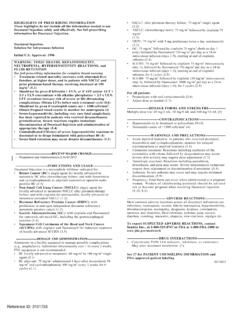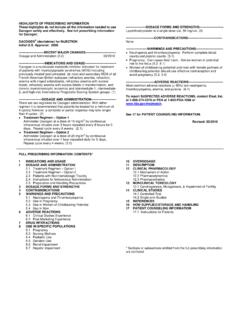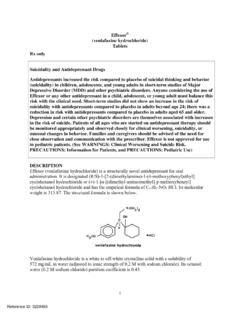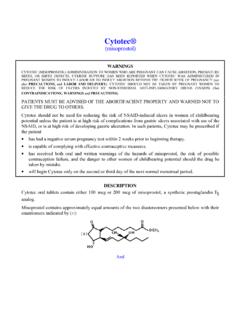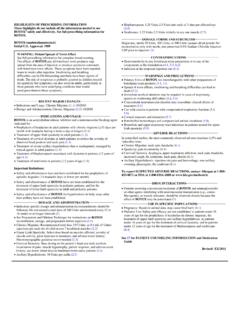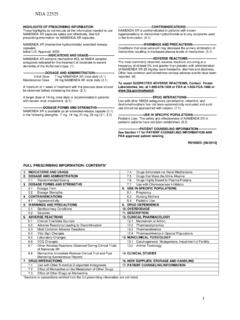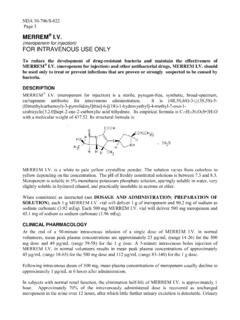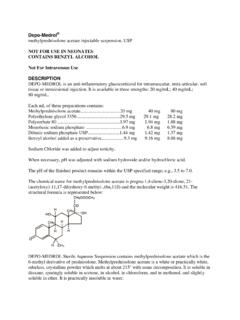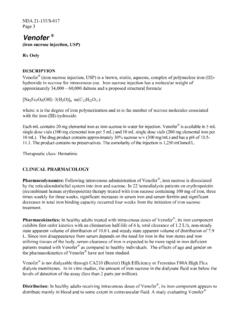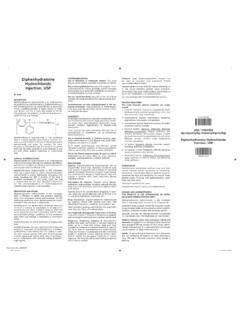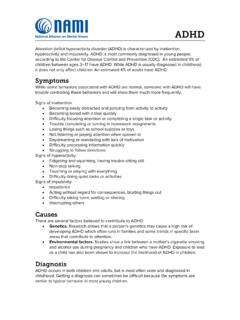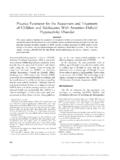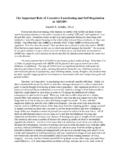Transcription of Reference ID: 3416347 - accessdata.fda.gov
1 HIGHLIGHTS OF PRESCRIBING INFORMATION Increase in Blood Pressure: Monitor blood pressure and pulse These highlights do not include all the information needed to at appropriate intervals. Use with caution in patients for use ADDERALL XR safely and effectively. See full whom blood pressure increases may be problematic. ( ). prescribing information for ADDERALL XR. Psychiatric Adverse Events: Stimulants may cause treatment - ADDERALL XR (mixed salts of a single-entity emergent psychotic or manic symptoms in patients with no amphetamine product) dextroamphetamine sulfate, prior history, or exacerbation of symptoms in patients with dextroamphetamine saccharate, amphetamine aspartate pre-existing psychosis. Evaluate for bipolar disorder prior to monohydrate, amphetamine sulfate capsules, CII stimulant use.
2 Monitor for aggressive behavior. ( ). Initial Approval: 2001 Long-term Suppression of Growth: Monitor height and weight at appropriate intervals. ( ). WARNING: POTENTIAL FOR ABUSE. Seizures: May lower the convulsive threshold. Discontinue See full prescribing information for complete boxed in the presence of seizures. ( ). warning Amphetamines have a high potential for abuse; Peripheral Vasculopathy, including Raynaud's phenomenon: prolonged administration may lead to dependence. (9) Stimulants used to treat ADHD are associated with peripheral vasculopathy, including Raynaud's phenomenon. Careful Misuse of amphetamines may cause sudden death and observation for digital changes is necessary during treatment serious cardiovascular adverse reactions. with ADHD stimulants. ( ). Visual Disturbance: Difficulties with accommodation and -----RECENT MAJOR CHANGES----- blurring of vision have been reported with stimulant treatment .
3 ( ). Warnings and Precautions ( ) 6/2013. Tics: May exacerbate tics. Evaluate for tics and Tourette's -----INDICATIONS AND USAGE----- syndrome prior to stimulant administration. ( ). ADDERALL XR, a CNS stimulant, is indicated for the treatment -----ADVERSE REACTIONS----- of attention deficit hyperactivity disorder (ADHD). (1) Children (ages 6 to 12): Most common adverse reactions Children (ages 6-12): Efficacy was established in one 3-week ( 5% and with a higher incidence than on placebo) were loss outpatient, controlled trial and one analogue classroom, of appetite, insomnia, abdominal pain, emotional lability, controlled trial in children with ADHD. (14) vomiting, nervousness, nausea, and fever. ( ). Adolescents (ages 13-17): Efficacy was established in one 4- Adolescents (ages 13 to 17): Most common adverse week controlled trial in adolescents with ADHD.
4 (14) reactions ( 5% and with a higher incidence than on placebo). Adults: Efficacy was established in one 4-week controlled trial were loss of appetite, insomnia, abdominal pain, weight loss, in adults with ADHD. (14) and nervousness. ( ). Adults: Most common adverse reactions 5% and with a -----DOSAGE AND ADMINISTRATION----- higher incidence than on placebo were dry mouth, loss of Pediatric patients (ages 6-17): 10 mg once daily in the appetite, insomnia, headache, weight loss, nausea, anxiety, morning. The maximum dose for children 6-12 is 30 mg once agitation, dizziness, tachycardia, diarrhea, asthenia, and daily. ( , , ) urinary tract infections. ( ). Adults: 20 mg once daily in the morning. ( ) To report SUSPECTED ADVERSE REACTIONS, contact Shire US Inc. at 1-800-828-2088 or FDA at 1-800-FDA-1088.
5 -----DOSAGE FORM AND STRENGTHS----- or Capsules: 5 mg, 10 mg, 15 mg, 20 mg, 25 mg, 30 mg (3) -----DRUG INTERACTIONS----- -----CONTRAINDICATIONS----- MAOI antidepressants are contraindicated; MAOIs potentiate Advanced arteriosclerosis (4) the effects of amphetamine. Do not administer ADDERALL. Symptomatic cardiovascular disease (4) XR during or within 14 days after use of MAOI. (4; ). Alkalinizing agents (GI antacids and urinary): These agents Moderate to severe hypertension (4) increase blood levels of amphetamine. ( ). Hyperthyroidism (4) Acidifying agents (GI and urinary): These agents reduce Known hypersensitivity or idiosyncrasy to the blood levels of amphetamine. ( ). sympathomimetic amines (4) Adrenergic blockers, antihistamines, antihypertensives, phenobarbital, phenytoin, veratrum alkaloids, and Glaucoma (4) ethosuximide: Effects may be reduced by amphetamines.
6 Agitated states (4) ( ). History of drug abuse (4) Tricyclic antidepressants, norepinephrine, and meperidine: Effects may be potentiated by amphetamines. ( ). During or within 14 days following the administration of monoamine oxidase inhibitors (MAOI) (4, ) -----USE IN SPECIFIC POPULATIONS----- -----WARNINGS AND PRECAUTIONS----- Pregnancy: Use only if the potential benefit justifies the Serious Cardiovascular Events: Sudden death has been potential risk to the fetus. Based on animal data, may cause reported with usual doses of CNS stimulants in children and fetal harm. ( ). adolescents with structural cardiac abnormalities or other Nursing Mothers: should refrain from breastfeeding. ( ). serious heart problems; sudden death, stroke, and myocardial infarction have been reported in adults taking CNS stimulants Pediatric Use: has not been studied in children under 6 years at usual doses.
7 Stimulant drugs should not be used in patients of age. ( ). with known structural cardiac abnormalities, cardiomyopathy, Geriatric Use: has not been studied in geriatric patients. ( ). serious heart rhythm abnormalities, coronary artery disease, or See 17 for PATIENT COUNSELING INFORMATION and other serious heart problems. ( ). Medication Guide. Revised: 11/2013. 1. Reference ID: 3416347 . FULL PRESCRIBING INFORMATION: CONTENTS*. WARNING: POTENTIAL FOR ABUSE and SERIOUS 8 USE IN SPECIFIC POPULATIONS. CARDIOVASCULAR ADVERSE REACTIONS Pregnancy 1 INDICATIONS AND USAGE Labor and Delivery Attention Deficit Hyperactivity Disorder Nursing Mothers 2 DOSAGE AND ADMINISTRATION Pediatric Use Dosing Considerations for all Patients Geriatric Use Children Adolescents 9 DRUG ABUSE AND DEPENDENCE. Adults Controlled Substance 3 DOSAGE FORMS AND STRENGTHS Abuse and Dependence 4 CONTRAINDICATIONS 10 OVERDOSAGE.
8 5 WARNINGS AND PRECAUTIONS 11 DESCRIPTION. Serious Cardiovascular Events 12 CLINICAL PHARMACOLOGY. Psychiatric Adverse Events Mechanism of Action Long-Term Suppression of Growth Pharmacokinetics Seizures 13 NONCLINICAL TOXICOLOGY. Peripheral Vasculopathy, including Raynaud's Carcinogenesis, Mutagenesis, Impairment of phenomenon Fertility Visual Disturbance Animal Toxicology and/or Pharmacology Tics 14 CLINICAL STUDIES. Prescribing and Dispensing 16 HOW SUPPLIED/STORAGE AND HANDLING. 6 ADVERSE REACTIONS 17 PATIENT COUNSELING INFORMATION. Clinical Studies Experience Information on Medication Guide Adverse Reactions Associated with the Use of Controlled Substance Status/Potential for Abuse, Amphetamine, ADDERALL XR, or ADDERALL Misuse, and Dependence 7 DRUG INTERACTIONS Serious Cardiovascular Risks Agents that Increase Blood Levels of Amphetamines Psychiatric Risks Agents that Lower Blood Levels of Amphetamines Circulation problems in fingers and toes Agents whose Effects May be Reduced by [Peripheral vasculopathy, including Raynaud's Amphetamines phenomenon].
9 Agents whose Effects May be Potentiated by Growth Amphetamines Pregnancy Agents that May Reduce the Effects of Amphetamines Nursing Agents that May Potentiate the Effects of Impairment in Ability to Operate Machinery or Amphetamines Vehicles Proton Pump Inhibitors (PPI). Drug/Laboratory Test Interactions *Sections or subsections omitted from the full prescribing information are not listed 2. Reference ID: 3416347 . FULL PRESCRIBING INFORMATION. WARNING: POTENTIAL FOR ABUSE. Amphetamines have a high potential for abuse. Administration of amphetamines for prolonged periods of time may lead to drug dependence. Pay particular attention to the possibility of subjects obtaining amphetamines for non-therapeutic use or distribution to others and the drugs should be prescribed or dispensed sparingly [see DRUG ABUSE AND DEPENDENCE (9)].
10 Misuse of amphetamine may cause sudden death and serious cardiovascular adverse reactions. 1 INDICATIONS AND USAGE. Attention Deficit Hyperactivity Disorder ADDERALL XR is indicated for the treatment of attention deficit hyperactivity disorder (ADHD). The efficacy of ADDERALL XR in the treatment of ADHD was established on the basis of two controlled trials in children aged 6 to 12, one controlled trial in adolescents aged 13 to 17, and one controlled trial in adults who met DSM-IV criteria for ADHD [see CLINICAL STUDIES. (14)]. A diagnosis of ADHD (DSM-IV ) implies the presence of hyperactive-impulsive or inattentive symptoms that caused impairment and were present before age 7 years. The symptoms must cause clinically significant impairment, , in social, academic, or occupational functioning, and be present in two or more settings, , school (or work) and at home.
